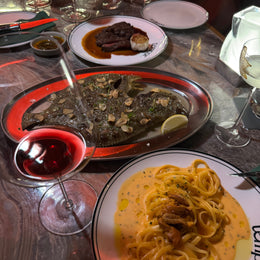Editor: Many thanks to Clement of La Maison du Whisky, Caron Chan of Accela and Miles Munroe of Westward Whiskey for this very insightful and enjoyable whiskey class! Singaporean readers keen to shop for Westward’s bottles can check them out at LMDW’s Whisky.SG. Asia-Pacific and Europe readers check out here.
“It is brewed like a pale ale, distilled like a Scotch single malt, then aged like a bourbon.”
–Miles Munroe, Head Distiller and Master Blender of Westward Whiskey.


The Pacific Northwest region of the United States is known for its laid-back inhabitants, striking natural beauty, links to the American pioneering spirit, and a thriving agricultural industry. This part of America boasts a number of renowned craft beer breweries and an equatorial latitude similar to the French Burgundy region – wine enthusiasts know this area for its exquisite American Pinot Noir and Chardonnay.

The event I’m attending tonight, however, is focused on another kind of liquid gold from the American Northwest – Westward’s Single Malt Whiskey. Founded by Christian Krogstad, Westward Whiskey is a whiskey made by House Spirits Distillery of Portland, Oregon.

As an interesting side observation, the distillery found early success in producing gin. Which gin brand did they create? This little-known brand called Aviation Gin! The distillery built up Aviation before it was sold in 2016 and attained Hollywood fame when Ryan Reynolds acquired a stake in Aviation and became its spokesperson. The distillery still produces Aviation Gin under contract for the new owners, but the team has since switched its focus to producing Westward single malt.

Sensing rising potential in American single malts, liquor giant Diageo invested in Westward Whiskey in 2018. This financing helped to expand production while maintaining Westward’s reputation of quality and regional identity in the Pacific Northwest.

This evening’s tasting session was led-by the Head Distiller and Master Blender, Miles Munroe, an effortlessly engaging storyteller. Miles began by sharing insights into Westward Whiskey's production process.

A bottle of Westward Whiskey begins its journey as locally-sourced Pacific Northwest two-row malted barley, which receives a medium roast that imparts roasty chocolate and nutty notes to the spirit – something I can confirm after being given to try the oily and very flavourful newmake (or “white dog” as American whiskeymakers call it).
According to Miles, Westward’s team sees itself as beer brewers-turned-whiskeymakers. Other producers use a higher alcohol-yielding yeast (known as “distiller’s yeast”), but Westward employs lower-yielding ale yeast for fermentation, conducted for up to 5 days straight at a low temperature.
This is a more costly and inefficient method, but one that imbues the whiskey with a ton more fruity esters and a rich malty character. Interestingly, the ale yeast used in Westward’s production is the same ale yeast used to brew my personal favourite Californian craft beer, the Sierra Nevada Pale Ale. Indeed, Miles himself had experience as a craft beer brewer begore making the transition to whiskey production.

The brewed wash is then double distilled using equipment similar to Scotch single malt pot stills, and matured in virgin American oak barrels. In Miles' words, "it is brewed like a pale ale, distilled like a Scotch single malt, then aged like a bourbon."

Today’s tasting experience features four Westward expressions. And from the get-go, you could smell how distinctively different each expression was.

You would notice that Westward's whiskies have no age statement - an intentional decision. According to Miles, their whiskies are usually aged for about 6 years (fairly substantial consider the fluctuating American climate) - with the first 5 years in virgin oak and an additional 1 or 2 years in a different cask style. When selecting casks, whiskey blenders like Miles (and Fuji Whisky's Jota Tanaka who had experiences as a bourbon-maker) have also trained been trained to age their whiskies to taste, rather than being beholden to a specific number of years.
Westward Original Single Malt

We began with the Westward Original, which had been matured in toasted and lightly charred virgin American Oak barrels. I haven’t tasted any American whiskey like this one.
It offers a bouquet of rich and dense aromas, starting with bright summer stone fruits like ripe peaches and apricots, and a subtle maltiness. On the palate, very layered and opens with chocolate-coffee notes, a touch of vanilla and toasted coconuts, and the unmistakable musky maltiness reminiscent of a Glenfiddich 15 and some malt beer. Lots of bright vanilla, caramel and orangey notes and a smooth but oily mouthfeel reminiscent of an oily Highlands-style unpeated ex-bourbon Scotch. As the primary flavours meld, a mild spiciness emerges in the middle of the tongue, likely derived from the virgin oak barrels used for aging. It leaves a warm and satisfying finish.
This is certainly very distinctly flavoured, opening with notes and texture Scotch so similar to a Highlands style Scotch, but significantly sweeter and fruitier, then rounding up with a maltiness of pale ale and light spiciness of American rye.
Westward Pinot Noir Cask

This began as the Original did, but had spent two additional years in French Oak ex-Pinot Noir casks from the Willamette Valley region north of Portland.

The result? Stunningly mellow, delicate and smooth in aroma and mouthfeel. On the palate, sweet and refined flavours of red fruits such as sultanas, figs and raspberries, intermingle with the familiar maltiness and chocolate notes, while the mouthfeel is much brighter and lighter. Towards the end, there is also a light nose of green grape juice and a whisper of oak.
This is very delicate and mellow, similar in texture to a typical Lowlands style Scotch, but again it does have quite a bit more going on.
Westward Stout Cask Finish

We’re not unfamiliar with stout cask whiskies – months ago I tried the famous Lagavulin Offerman Edition Guinness cask expression. But Westward’s stout cask once again brings something new to the table.
This intriguing expression pays homage to Westward Whiskey's beer brewing roots, and the whiskey had been aged for one year in first-fill Stout-seasoned casks sourced from Deschutes Brewery - one of the distillery's craft brewing partners in the Northwest. These brewers themselves have a special arrangement with Westward to use Westward’s whiskey casks on loan for barrel-aging their stouts, before returning the casks to Westward while still wet with beer.
The Stout Cask Finish offers a yet more pronounced flavour profile than both the Original and Pinot Noir. It has a sweet and malty nose that hints at graham crackers, honeycomb and almost-funky overripe grapes. Upon tasting, I get Milo’s chocolate malt drink, Nesquik milk chocolate, banana ice cream, almond praline, and the dryness of roasted walnuts that add depth and character. The finish lingers with rich chocolate and nutty flavours.
This is the richest and most distinctively flavoured of the first trio, and my favourite. I ended up purchasing a bottle from La Maison du Whisky’s bar.
Westward Cask Strength

We finally turned to the final unlabelled dram on our table, which we initially had no idea of its identity. Miles urged the class to have a sip of the whiskey, and guess the alcohol proof of it.
It is pretty clear that the Master Blender intended to make a point. The level of heat and texture felt like a 55% ABV whiskey in the mid-range, nothing higher than 60% ABV.
Compared to the Original, The Cask Strength certainly held a stronger punch and even denser flavours. It begins with the rich maltiness and jammy bright fruit flavours, and as the flavours develop, well-rounded notes of rich cacao, dry oak and dates, with a long and satisfying finish of spicy, zesty ginger.
Miles Munroe's vision for this offering is a cask strength whiskey that could let you “have your cake and eat it”. Essentially, to create a highly flavourful cask strength bottle but without the “cost” of drinking typical cask strength spirits that painfully burn the back of the throat as they go down.
It seems to me that Miles has done a decent job. This appears an intensified version of the Original, with a pronounced but moderate sensation of spiciness at the back of the throat, which makes for a flavourful cask strength dram that comes with no regret attached.
A Celebration of terroir, innovation and the Pacific Northwest spirit
Modern Americans continue to hold admiration for the early settlers who ventured “westward” into that region and developed a deep understanding of the land to survive the otherwise harsh and challenging environment. Westward prides itself as a brand that celebrates this “pioneering spirit” of the Pacific Northwest in the way it is made from the unique culture, climate and local resources of the region.

These days, “terroir” and “innovation” are commonplace in ad copies and promotional messages of wine and spirit makers. Yet, if you use words like that too often, they quickly lose all meaning. Mainstream consumers are bound to gloss over such terms when it feels like producers are simply doing terroir of terroir’s sake. How significant are these elements? And how much do they really affect the taste of the spirit?
When it comes to Westward, however, I do feel quite compelled by its message on terroir. The distillery weaves together elements of local barley, Willamette Valley’s red wines, Stout casks and techniques from the region’s vibrant craft brewing scene and really make them work. Its whiskies are distinctive, and each expression showcases the house style with interesting, delicious twists.
American single malt has been around for years. Yet internationally, we are only just witnessing the burgeoning days of American single malt steadily reach the glasses of whiskey lovers around the world. I’m thrilled that my first taste of American single malt at the hands of Westward was a thoroughly enjoyable experience. I’m excited to see what’s next from Westward Whiskey and the American single malt category.
Looking ahead, Miles disclosed that Westward latest upcoming project is to produce whiskey finished in Nicaraguan rum casks. I'm sure all of us who have tasted the whiskies today would be waiting for that rum cask release with bated breath.

Good American whiskey aren't always easy to come by in Asia. For readers here who have yet to explore the world of American single malts, I wholeheartedly recommend starting this fascinating journey with Westward. Whether you're a connoisseur or simply curious about the fusion of beer brewing and whiskey making, Westward Whiskey's expressions are sure to leave a memorable impression about the category.
Singaporean readers keen to shop for Westward’s bottles can check them out at LMDW’s Whisky.SG. Asia-Pacific and Europe readers check out here.

@CharsiuCharlie







